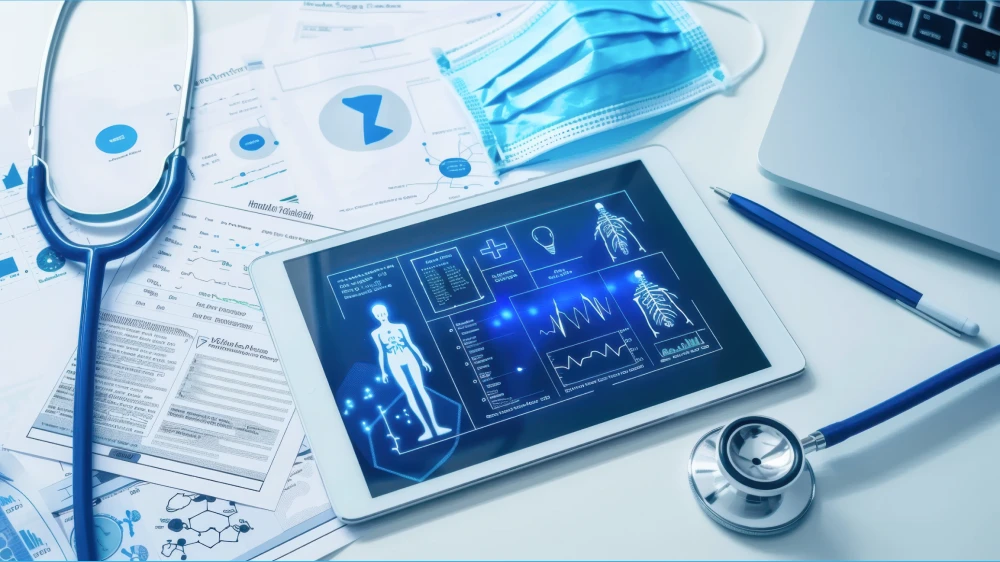As the volume of data from electronic health records, wearable devices, and patient interactions continues to grow, organizations face both an opportunity and a challenge: How can we harness this data to drive better patient outcomes, reduce costs, and optimize operations? Predictive analytics in healthcare is the answer.
By leveraging advanced data analytics, machine learning, and artificial intelligence, predictive models allow healthcare organizations to move from reactive to proactive care. Over 95% of physician groups and hospitals have access to advanced analytics to support their decision-making, but only a small percentage use them to their full potential.
In this article, we’ll explore how predictive analytics works in healthcare, the challenges during implementation, and how you can harness its full potential to drive value for your organization and your patients.
What is Predictive Analytics In Healthcare?
Predictive analytics in healthcare uses historical and real-time data combined with advanced technologies like AI, machine learning, and data mining to predict future outcomes. In healthcare, this means anticipating patient needs, identifying trends before they become critical, and optimizing operations to help healthcare organizations work smarter, not harder.
At its core, predictive analytics ingests massive amounts of data from electronic health records (EHRs), insurance claims, administrative records, etc.—and then applies statistical models to translate those raw data into actionable insights. Healthcare organizations can use these insights for remote patient monitoring and personalized individual care.
By leveraging predictive insights, organizations have a clear path toward a more innovative, data-driven healthcare system better equipped to meet the challenges of today and the future.
Main Benefits of Predictive Analytics in Healthcare
Predictive analytics has become an essential part of any health analytics strategy by offering benefits that truly matter for caregivers and patients, including:

- Enhanced Patient Care and Outcomes
- Cost Reduction and Efficiency Improvements
- Enhanced Disease Management
- Personalized Medicine
- Improved Health Insurance Models
1. Enhanced Patient Care and Outcomes
Predictive analytics enables healthcare providers to identify high-risk patients before symptoms even surface.
By analyzing data from EHRs and other sources, providers can spot early signs of chronic conditions like diabetes, heart disease, or COPD. The data allows for early interventions that prevent hospitalizations and improve long-term patient health.
The ability to predict who might need attention before a critical event occurs creates a ripple effect—patients get better care, hospitals reduce their burden, and the overall cost of care goes down.
2. Cost Reduction and Efficiency Improvements
Healthcare systems are constantly under pressure to do more with less. Predictive analytics can help meet that challenge by optimizing resource allocation and streamlining operations.
Hospitals can better manage bed occupancy, staff, and the supply chain by predicting patient admissions. Fewer unnecessary procedures and reduced readmission rates also drive down operational costs. In short, predictive analytics in healthcare turns data into a roadmap for more efficient, cost-effective care delivery.
3. Enhanced Chronic Disease Management
Chronic disease management is one of the biggest challenges in healthcare. With predictive analytics, healthcare organizations can monitor patients’ health data in real-time, catching potential issues before they escalate.
Wearable devices, for example, provide real-time data that can help predict flare-ups in conditions like asthma or diabetes, enabling clinicians to intervene sooner. This reduces emergency room visits and hospitalizations, allowing patients to manage their conditions more effectively from home.
4. Personalized Medicine
One size rarely fits all in healthcare. Predictive analytics helps pave the way for personalized medicine by analyzing genetic, environmental, and lifestyle data to tailor treatments to each patient. With these insights, healthcare providers can develop treatment plans that are more likely to succeed, minimizing the guesswork of traditional methods.
Personalized medicine improves patient satisfaction, delivers better outcomes, and reduces the costs associated with ineffective treatments.
5. Improved Health Insurance Models
Predictive analytics also brings value to healthcare payers by creating more accurate risk models. By analyzing lifestyle choices, medical history, and usage data, insurers can better assess risk and create fairer, more personalized premiums.
Additionally, predictive models can flag potentially fraudulent claims, improving claims processing efficiency and ensuring providers allocate resources where needed.
Notable Applications of Predictive Analytics in Healthcare
Predictive analytics is doing more than just predicting outcomes. From clinical care to operational management, the real-world applications of predictive analytics are proving its undeniable importance. Here are some key ways providers put it to use:

- Clinical Predictions and Research
- Enhancing Patient Engagement
- Early Disease Intervention
- Resource Management and Procurement
- Reducing Hospital Stays and Readmissions
- Strengthening Cybersecurity
1. Clinical Predictions and Research
Predictive analytics is enabling healthcare providers to anticipate medical conditions before they happen. By applying machine learning algorithms to patient data, care providers can identify the probability of a condition developing based on past outcomes.
A striking example comes from the COVID-19 pandemic. Predictive models were used to assess over 170,000 patient records, allowing hospitals to predict the severity of cases and prioritize care. Using the study to identify high-risk patients early helped lower mortality rates significantly, from 16.4% to 8.6% in six months.
2. Enhancing Patient Engagement
Missed appointments and poor treatment adherence can have costly consequences for patients and healthcare providers. Predictive analytics in healthcare identifies which patients are at high risk of non-compliance or no-shows, giving healthcare organizations a chance to intervene early.
By analyzing patient behavior patterns, care teams can tailor follow-up strategies, ensuring patients stay engaged with their treatment plans. Equipped with these insights, clinicians can have better resource planning to improve patient outcomes, all while minimizing wasted time and resources.
3. Early Disease Intervention
Catching diseases early saves lives and reduces the long-term cost of care. Predictive analytics makes early detection more precise by analyzing vast amounts of patient data to predict the likelihood of disease progression before symptoms become severe.
For instance, predictive models for cardiovascular disease risk have already proven successful, allowing for early interventions that significantly reduce long-term complications. With diseases like diabetes and hypertension on the rise, predictive analytics helps healthcare organizations take action sooner, preventing costly hospitalizations and improving patient quality of life.
4. Resource Management and Procurement
Managing resources efficiently is a constant challenge in healthcare’s complex systems. Predictive analytics in healthcare allows organizations to forecast supply, medications, and staff demand based on historical data and seasonal trends. Hospitals can better manage everything from bed occupancy to staff allocation, ensuring they are prepared for surges in demand.
By predicting future needs, healthcare providers can prevent shortages and ensure that resources are always available when they’re needed most
5. Reducing Hospital Stays and Readmissions
Overextended hospital stays and frequent readmissions can be a drain on healthcare systems. Predictive analytics helps mitigate these issues by predicting the ideal discharge time for patients and balancing recovery with the risk of readmission.
Hospitals can then implement targeted follow-up care or discharge planning that keeps patients healthier after they leave. Predictive models also identify patients who may benefit from shorter stays, freeing up valuable resources without compromising patient care.
6. Strengthening Cybersecurity
As healthcare is digitized, it becomes a prime target for cyberattacks. Data protection is now a top priority, and predictive analytics is pivotal in making that possible.
Predictive analytics enhances cybersecurity by analyzing access patterns and detecting anomalies that could indicate security threats. Also, machine learning models can flag suspicious activity in real time, enabling organizations to take preventative measures before a breach occurs.
There are two main types of predictive models used in healthcare cybersecurity:
- Vulnerability-based solutions: Identify weaknesses in the system, such as unpatched software.
- Threat-focused solutions: Actively search for potential security threats.
Overcoming Common Challenges of Healthcare Predictive Analytics
Predictive analytics holds immense potential for improving healthcare, but it’s not without its challenges. The implementation of advanced analytics in a field as complex as healthcare presents obstacles that need to be addressed.

1. Getting Providers’ Approval
Healthcare providers are often stretched thin, balancing patient care with administrative tasks. Introducing predictive analytics into their workflow can feel like an added burden, especially when it requires learning new tools or capturing more data during patient interactions.
Solution: Involving healthcare providers in the development process is critical. By incorporating their feedback from the start, predictive tools can be designed to integrate seamlessly into daily workflows and minimize disruptions. Training and ongoing support also play vital roles in ensuring providers are comfortable using analytics to enhance patient care.
2. Ethical Considerations
People are more likely to engage in risky behavior when they know someone’s got them covered. In healthcare settings where doctors rely excessively on predictive analytics for decision-making, they can be under the assumption that these tools bear the responsibility for outcomes.
It’s crucial to emphasize that decisions made by analytical tools are not definitive mandates but rather recommendations. Clinicians can minimize risk by critically evaluating these suggestions and, if needed, involve patients in the decision-making process.
Predictive analytics in healthcare offers recommendations based on data, but the ultimate responsibility for decisions still lies with the healthcare provider. Relying too heavily on algorithms can lead to overconfidence in the data, potentially reducing the role of human judgment in critical situations.
Solution: Remember that predictive healthcare tools are exactly that — tools, not replacements for clinical decision-making. Encouraging providers to maintain a balance between analytics and their expertise will foster better decision-making and more personalized care.
3. Algorithm Bias
Algorithm bias can skew predictive outcomes when the data used to train models doesn’t represent diverse patient populations. Bias in predictive models can lead to unequal care, with certain groups receiving less accurate predictions.
Solution: Regular audits of predictive models and a feedback loop from end-users help ensure the algorithms remain accurate and fair. Healthtech organizations must work closely with vendors to continually refine their models, addressing any bias.
4. Privacy Pressures
With predictive analytics, data is king, and the more data used, the more accurate the predictions. However, greater reliance on data raises privacy concerns, especially in healthcare, where sensitive patient information is involved.
Solution: Organizations must balance the need for comprehensive datasets with strict privacy controls. De-identification, encryption, and access control protocols are a must to ensure that data remains secure and compliant with regulations like HIPAA.
The Future of Predictive Analytics in Healthcare
The future of predictive analytics in healthcare seems bright.
Emerging technologies such as artificial intelligence (AI) and machine learning are pushing the boundaries of what’s possible. As these technologies evolve, they will unlock deeper insights by analyzing vast amounts of data and uncovering patterns that are difficult for humans to detect. Predictive analytics will be able to deliver even more precise and actionable insights.

Moreover, wearable devices and health trackers are becoming more common, providing real-time data for predictive models. These devices turn valuable information into useful data to make accurate predictions.
The shift toward value-based care also accelerates the rise of predictive analytics in healthcare. As healthcare moves from fee-for-service models to outcomes-based reimbursement, the ability to predict health risks, reduce readmissions, and optimize resource use is a crucial competitive edge.
Looking ahead, predictive analytics in healthcare holds great promise. Embracing advanced analytics today means staying ahead of the curve and leading the charge toward a more innovative and predictive healthcare system.
FAQs

1. How big is the predictive analytics market in healthcare?
The global healthcare predictive analytics market was valued at USD 9.21 billion in 2022, and experts predict it will reach USD 30.71 billion by 2028, growing at a CAGR of 22.23%. This healthy growth is due to AI’s adoption in major healthcare areas worldwide.
2. What are the three types of predictive modeling?
Predictive analytics often employs three types of models:
- Classification models fall under supervised machine learning models. They categorize data based on historical trends, helping to illustrate relationships within the data.
- Clustering models fall under unsupervised learning. They group data based on similar attributes.
- Time series models use data over specific time intervals (daily, weekly, etc.) to predict trends and patterns.
Blend Advanced Analytics into Your Organization with KMS Healthcare
Predictive analytics has a solid place in the future of healthcare delivery. It’s more than just predicting the future. Predictive analytics supports healthcare organizations in shaping it.
Know that predictive analytics isn’t a one-time project. As your organization grows and evolves, so should your analytics strategy. To unlock the full potential of this technology, you need a partner with the right expertise to guide you through this journey.
At KMS Healthcare, we specialize in helping healthcare organizations implement advanced analytics and business intelligence (BI) solutions. Our team of experts will work with you to build, innovate, and integrate data solutions customized to your needs:
- Deep Healthcare Expertise: Our team understands the unique complexities of healthcare data. We build analytics solutions that address the nuances of clinical workflows and regulatory compliance.
- Advanced Data Models: We leverage machine learning and AI-driven models to bring real operational efficiency and business outcomes.
- Customizable and Scalable BI Solutions: Our predictive analytics platforms are designed to grow with your organization.
Contact us to see how we can help your organization thrive with data or simply start by exploring our BI and data analytics services.
